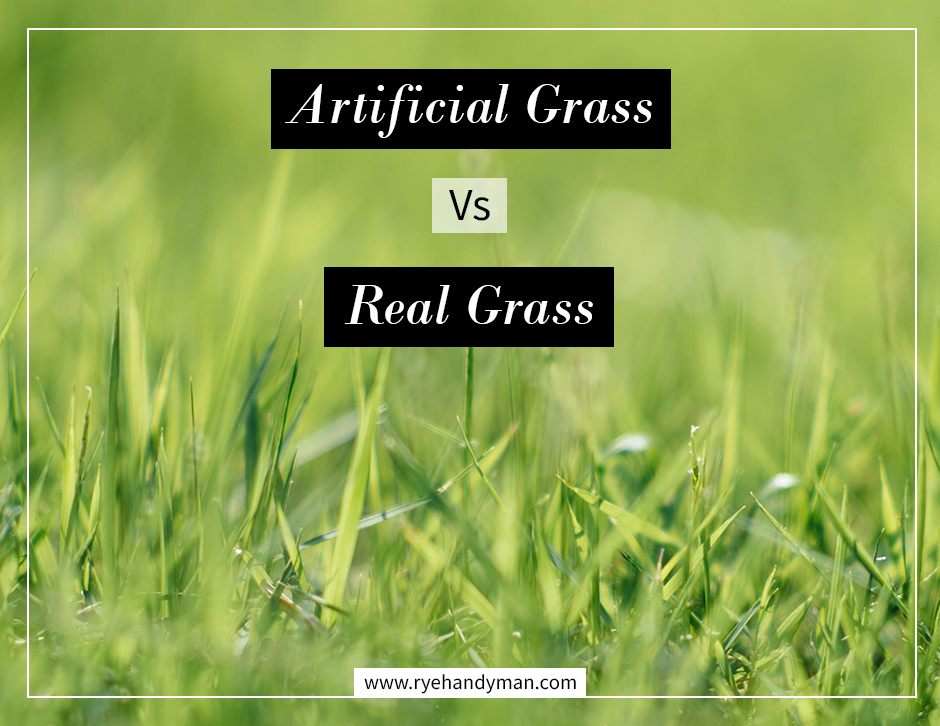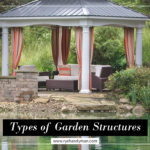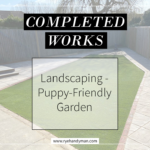
Artificial Grass vs Real Grass

A well-kept garden can be beautiful but hard work to maintain, so low maintenance gardens are a popular option for those that wish to enjoy being outside with as little work as possible. Many people are turning to paving and decking to fill their space but some still want that lush greenery. In this post we look at artificial grass versus real grass and compare their benefits against their drawbacks.
Artificial grass has gone through many changes in design and process over the years, and nowadays the design is so much more realistic compared to the original. First generation turf had very short fibres with no infill and was visibly artificial, whereas nowadays the fibres are longer with a layer of short infill.

There are three basic materials used in modern artificial grass:
Nylon – ‘bristles’ are stiff and strong, so not ideal as a soft play area in a garden. Best used on athletic fields and putting greens, and the most expensive out of the three.
Polypropylene – used in domestic gardens and the least expensive of the three but can deform under long heat exposure and is the least durable.
Polyethylene – soft to touch and the most realistic so perfect for gardens – especially for households with pets and/or children.
Benefits:
– Keeps its colour and structure all year round – no yellowing, patchiness or weeds.
– Doesn’t require regular mowing, feeding or watering.
– Child and pet-friendly.
– Ideal for the older generation who may struggle to keep up lawn mowing and maintenance.
– Long-lasting, with a potential life expectancy of up to 15 years.
– Can be recycled when it’s time to replace.

Drawbacks:
– Dependent on the supplier, some of the production processes of artificial grass can be environmentally damaging. Always research your chosen product and supplier thoroughly.
– The initial outlay – including professional installation – can be expensive.
– Some consider the artificial turf to be too artificial – and sometimes it can be fairly obvious that it’s exactly that.
– Artificial turf can reduce the biodiversity of a garden, as it removes a natural habitat for wildlife species.
Maintenance:
– Brush or rake regularly, especially in high footfall areas to remove debris and ensure it doesn’t flatten too much.
– If you need to clean up stains, use diluted bleach or vinegar. Harsher household cleaners can damage the grass.
– Make sure that no weeds grow underneath the matting, as this can cause movement and distortion (the turf is pinned into place).
– Wash the whole lawn occasionally with your garden hose – don’t use a pressure washer as this can cause distortion.
– If you have a pet that regularly uses your garden you may find there is a build-up of urine smells over time. Washing the area as quickly as possible with water is ideal, but if you don’t have the time, sprinkle baking soda on the affected patch and clean off later with a mild solution.
– Never use a BBQ or smoke near an artificial lawn, to ensure no hot sparks or ashes catch it alight.

Benefits:
– Natural grass and lawns are an important part of your garden’s ecosystem, providing shelter for a variety of insects and wildlife.
– Grass absorbs carbon dioxide and produces oxygen, which is beneficial to the environment.
– Green spaces and plants have been shown to reduce stress and improve wellbeing.
– Real grass is soft and many people’s preferred surface for children and pets to play on.
Drawbacks:
– Ongoing maintenance requires both a lot of effort and investment into tools, watering, feed, etc and can be more costly than you realise.
– As with all natural plants, grass is subject to temperature changes, weather conditions and usage, so may not stay the perfect lush green you want all the time and again would require some attention to keep it looking good.
– Chemicals used in feeding and watering can be absorbed into the water table which can be harmful to the environment.
– Watering the lawn requires a large amount of water which can be considered wasteful.
Maintenance:
– Aerate the lawn in high foot-fall areas where the grass gets flattened and compacted over time.
– Mow regularly – especially during spring and summer – to keep it looking neat and encourage root growth which prevents weeds from growing through.
– If you do get weeds popping up, make sure you remove them as soon as you can. Raking over the area before mowing will loosen them and help the mower pick them up which kills them over time.
– Water the whole lawn occasionally during hot dry weather but don’t over water. Grass can be fairly hardy and even if it is does brown off during the summer it will turn green again with enough rain.
– Feed your lawn with fertiliser to keep it healthy and encourage growth. Choose a day where rain is forecast to ensure it gets washed down to the roots and is less likely to burn the blades.
– If you get bare patches, fill them using grass seed or unused turf.




